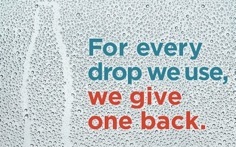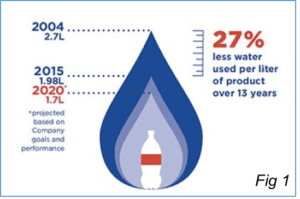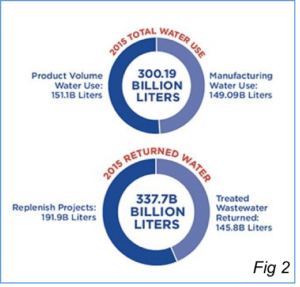Is Coca Cola staying ahead of Climate Change?

A short report summarising the impact of climate change on Coca Cola’s business and resulting sustainability initiatives undertaken by the firm.
Climate scientists have provided constant evidence that increased GHG emissions from human activity has led to a gradual increase in our atmosphere’s average temperature and extreme changes in precipitation patterns, ultimately leading to the world becoming a ‘drier’ place.
For Coca Cola (Coke), which sells its products in over 200 countries across the globe, water is the lifeblood of their business. It is needed to grow agricultural ingredients, used in manufacturing, and essentially the core element in each of their products. As of 2015, ~2L of water is used in producing 1L of Coke. As such, Coke not only suffers direct risks from scarcity of its primary ingredient, but far more importantly a huge reputational risk as the nature of its business puts it in direct conflict with a basic human right to water (Resolution 64/292 United Nations General Assembly in 2010).
Growing up in India, I first saw the emergence of this conflict when in 2005, Kerala state authorities forced closure of one Coke bottling plant for mismanagement of water resources. 10 years on and the company was still battling such issues – the government forcing closure of an old inefficient plant in Varanasi and withdrawing land allocated for a new bottling plant in Tamil Nadu following large scale community protests.
Growing conflicts through the years has led to a realization that climate change will likely have long-term direct and indirect implications for their business and supply chain. As such, efforts have been made to reduce the adverse impact of their manufacturing process on local communities. The key initiatives undertaken revolve around the following 3 themes:
Operational Improvement and Wastewater Management:
Over the years, Coke has been making improvements in their manufacturing processes and also significant investments in equipment technology to reduce the volume of water required for producing their beverages. While in 2004, each litre of Coke required ~2.7L of water, this has dropped to ~2L in 2015 (see Fig 1). Additionally, modern technology has enabled Coke to process, clean and then return traditional ‘wastewater’ to the communities. As on 2015, Coke was using 149 Billion Litres of water to support their manufacturing processes, of which ~146 Billions Litres was treated and returned (see Fig 2)
Source Water Assessments and Protection Plans:
Initially used as a design criterion for new bottling plants, Coke now requires all bottling plants to conduct a local source water vulnerability assessment (SVA) and subsequently develop source water protection plans (SWPP). These projects are often done in collaboration with local communities and governments and other respected third-party partners. In many cases, projects also help improve local livelihoods, help communities adapt to climate change, improve water quality and enhance biodiversity.
Water Replenishment Projects
In 2007, Coke took on a bold goal to replenish all the water it uses globally by 2020. Since then the company has implemented 248 community water partnership projects in 71 countries focused on rainwater harvesting, safe water access and watershed protection. Replenish projects have been implemented in the areas where the need is greatest and where the firm has the resources and partnership opportunities to make a lasting impact. For e.g. many such projects were conducted with the expertise and support of many critical partners such as WWF, USAID, The Nature Conservancy, Water for People, and the United Nations Development Programme (UNDP).
As of Aug 2016, Coke announced that they have met the goal to replenish their consumption, which led to a new tagline for their sustainability campaign “For every drop we use, we give one back”. The methodology to calculate water replenishment benefits was created by The Nature Conservancy and LimnoTech and the performance was independently verified by Deloitte.
Next Steps
Although Coke has made significant strides to mitigate the impact of climate change, I believe there are two key areas Coke has not yet focused on:
- Coke’s Replenish projects are not always to the aquifer from which the water was originally sourced. The strongest critics question the act of ‘balancing’ when depletion of certain community aquifer is mitigated by replenishing water in another community aquifer that may be hundreds or thousands of miles away. I personally believe that Coke must double down on efforts to ensure that replenishment actually benefits the communities that were impacted by their operations.
- Currently, the water footprint of growing agricultural ingredients sourced by the Coke system is not included in their water replenishment goal. To achieve true sustainability, the company must additionally focus their efforts on training, motivating and incentivizing their supply chain to implement the ‘Sustainable Agriculture Guiding Principles’ laid out by Coke.
I truly believe that with the right vision and dedicated efforts, even much maligned industries can make a substantial impact on mitigating the risk of climate change.
(786 words)
Sources:
- http://www.coca-colacompany.com/sustainability
- http://www.coca-colacompany.com/water-stewardship-replenish-report
- http://www.coca-colacompany.com/stories/treating-and-recycling-wastewater
- http://www.nytimes.com/2014/01/24/science/earth/threat-to-bottom-line-spurs-action-on-climate.html?_r=0
- http://www.globalresearch.ca/the-privatization-of-water-in-india-how-cocacola-destroys-the-aquifer/5472625





I really liked this article. I have always been skeptical of cola companies and the damage they cause to the environment because of their poor water use practices. It is “refreshing” to see Coke actually putting in so much effort and thought into replenishing water. The crux however lies in the first reservation you pointed out i.e. where is use of water and where does Coke replenish it. Example, in some parts of India (Karnataka to be specific) this is a major issue. If Coke uses water from one source river but then replenishes it back to another, that is not necessarily the same as replenishing the same river. You’ve identified this issue absolutely head on and I think that’s what Coke should focus on going forward.
Great post, Nikhil. As social media and the internet have created the ability to spread local messages worldwide, activists have gained increasing power against large companies like Coca-Cola. This trend is encouraging for holding companies accountable to community stakeholders who are impacted by negative externalities these companies produce. You’ve highlighted several examples of these activists shutting down plants in India and forcing new corporate initiatives at Coca-Cola which shows just how much power these activists have gained. What this shows to me is that corporate social responsibility efforts to increase sustainability must start with local community engagement. By listening and responding to these voices, Coca-Cola can develop the right plans to mitigate concerns and operate ethically around the globe.
Nikhil,
I really appreciate your personal touch to this blog post and great suggestions for how Coca-Cola can refine this already impressive strategy. I have heard through the years about how Coca-Cola struggled to enter and maintain market share in India due to some of these initial challenges they faced and public backlash. I wanted to also highlight some of the other important efforts in addition to water that Coca-Cola makes towards sustainability because they give us a more full picture of how much they really invest. Some efforts include:
1. Polar Bear Protection-Coca-Cola has committed $3 million over 5 years to partner with the World Wildlife Fund and conserve polar bear populations (1).
2. Signed onto the White House’s American Business Act on Climate Change pledge–Coca-Cola committed to reduce its carbon footprint by 25% by 2030 in this agreement and was influential in the COP 21 negotiations in Paris in December 2015 (2).
3. Targeting 2020 for going all hydrofluorocarbon (HFC)-free in cold-drink dispensers (1).
4. Work with partners to recover and then recycle used bottles and cans-Coca-Cola has set a goal of recycling 75% of them by 2020 (1).
5. Save on energy by creating more efficient manufacturing processes through factories (1).
I think even just these select few highlight how much Coca-Cola does as an entire company to help the environment. It’s very impressive what incredible resources a company this large has and the impact it can have on climate change.
Parker
Sources:
1) http://www.coca-colacompany.com/climate-protection-report
2) https://www.whitehouse.gov/the-press-office/2015/11/30/white-house-announces-additional-commitments-american-business-act
Could Coca Cola use the wastewater from its soda production in a more innovative way? It’s possible to produce bioethanol from wastewater that contains as little as 10-12% sugar weight by volume by adding the correct strain of yeast[1]. By distributing this biofuel to the surrounding communities perhaps they could further mitigate their impact.
Going even further, perhaps they could aim for a more aggressive net waste goal. If they’re outputting greywater to the surrounding community, it would be proactive of them if they could further purify it and use it in their products.
[1] Isla, M., 2013. Wastewater from the soft drinks industry as a source for bioethanol production. Bioresource Technology, 136, 1.
Hey Nikhil. I think you have brought out the issue really well. Particularly striking was how Coca Cola was replenishing aquifers that were not even serving the local population. Just like there are strict domestic regulations in the US and the UK around foreign corrupt practices done by US and UK companies abroad, I think it is high time that there are regulations that govern the environmental practices of these companies. Penalizing them for not doing right by local communities is important especially when local governance mechanisms may not be adequately strong.